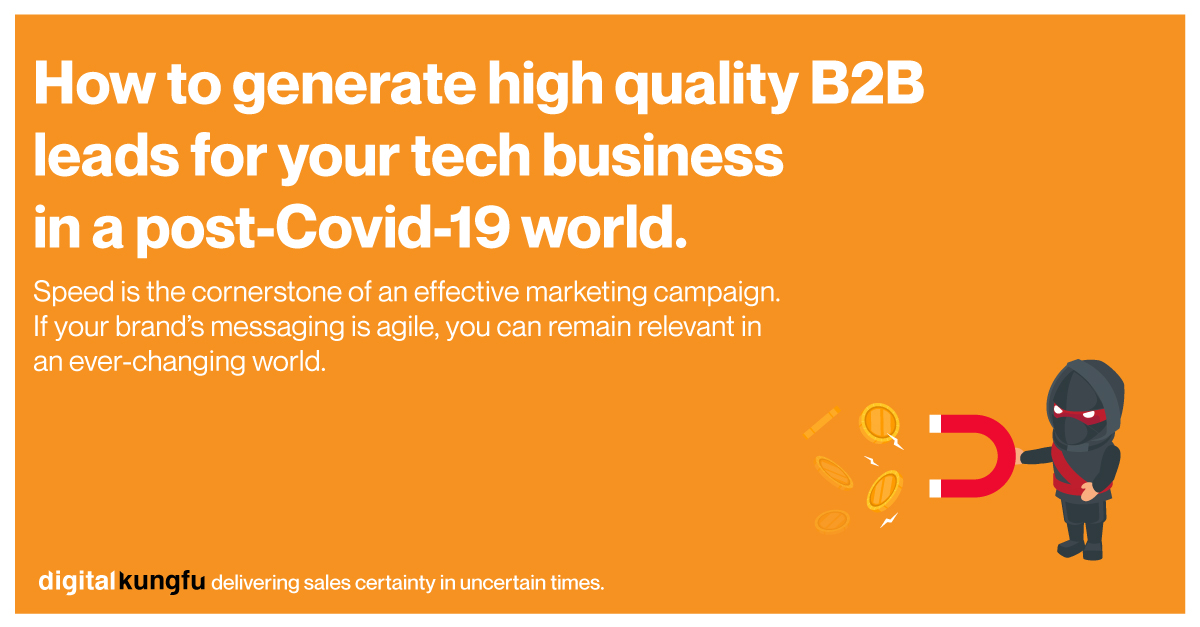The world is more competitive than ever before. The Covid-19 pandemic has accelerated change in an unprecedented way and decision makers are reevaluating the businesses they work with and the solutions they deploy across their organisations.
The good news is that this presents technology businesses with a huge opportunity. If you are able to adapt to new customer needs and demands and connect with key decision makers, you will build a better, stronger and more sustainable business in a post-Covid-19 world.
Here are six proven ways to generate a sales-ready pipeline during a recession.
- Cut through the clutter
Your top priority should be to ensure that your potential customers know who you are and how you can solve their pain points. This means that your marketing campaigns need to stand out amongst thousands of adverts that B2B buyers are exposed to every day.
How do you do this? You ensure that your message is 100% tailored to a real need or challenge your customer is facing so that they don’t filter your message out.
Great messaging is meaningless unless people see it though, which is where algorithms come in. The right digital tools ensure that your ideal target audience see the media you place in the market, and real-time tracking algorithms can help you optimise your campaigns.
Download Digital Kungfu’s eBook: 6 proven strategies that deliver sale qualified pipeline during a recession to discover how to implement these 6 strategies in your business and increase sales your sales today.
- Achieve marketing results in weeks, not months
The pace of the technology sector is not slowing down. If anything, it’s speeding up, which mean if you want to remain competitive, you need to get to market in days, not months.
Campaigns that are slow and expensive to take to market don’t work for technology companies. To remain competitive, technology businesses and independent software vendors need to adopt an agile marketing approach that consistently re-enforces their desired positioning.
One product video or brand advert won’t cut through the noise sufficiently enough to capture new market share or generate the leads and new business these companies are aiming for, which means you need to be consistently speaking to target audiences with relevant messages.
More importantly, you need to be able to adjust to market feedback, which means real-time optimization based on how target audiences are responding to messaging. You can’t rigidly follow a marketing plan. You need to be able implement rapid iterations based on testing different material, collecting data and responding to it.
The answer is Agile Marketing methodology, which follows the same principles as Agile Software Development, and therefore shares the same values. These include:
- Responding to change over following a plan
- Rapid iterations over Big-Bang campaigns
- Testing and data over opinions and conventions
- Multiple small experiments over a few large bets
- Collaboration over silos and hierarchy
- Learn to tell your story
Resellers of software products and independent software vendors have a big challenge on their plates: Namely how to shorten the time it takes for their target customers to understand the value of the products and services they are selling and why the customer should buy from them and not one of their competitors.
There are 5 elements to telling a great story:
- Distil a complex solution into a compelling story that resonates with customers.
- Make them the hero – not your solution. You are merely the facilitator of victory.
- Focus on what their businesses would look like in the absence of your solution, as well as with your solution.
- Get your message into the market quickly so that you can optimize it in real-time.
- Your messaging must be replicable, consistent and repeatable. You can’t educate a market through one advert. You need constant messaging that builds on your brand story.
- Differentiate yourself with Account Based Marketing
Account Based Marketing (ABM) is a key driver of alignment between sales and marketing within businesses. B2B organisations with tightly aligned sales and marketing operations achieve 24% faster three-year revenue growth and 27% faster three-year profit growth, according to SiriusDecisions.
ABM is a strategic approach to B2B marketing that targets specific accounts, personalising communications and content to customers. It’s a one-on-one approach as opposed to a one-to-many approach in the traditional marketing landscape.
ABM helps businesses achieve the following three key results with their marketing spend:
- Engage with prospects earlier in the sales process, focusing specifically on higher-value opportunities
- Align strategic marketing initiatives with sales and account management strategies
- Maximise ROI from marketing campaigns and derive full value from any content generated.
Download Digital Kungfu’s eBook: 6 proven strategies that deliver sale qualified pipeline during a recession to discover how to implement these 6 strategies in your business and increase sales your sales today.
- Mine your existing data for gold
Did you know that bad data is costing UK-based businesses millions each year?
Most businesses understand the need for a customer relationship management (CRM) system, but the data in these systems often just gathers dust. This is because the flow of inbound leads that a business receives must be monitored to ensure that only good data is inputted into the system for sales executives and account managers to work with.
Why is this important? It costs five times more to acquire a new customer than it does to retain an existing customer. On top of that, the success rate of selling to a customer you already have is 60% to 70%, while the success rate of selling to a new customer is only 5% to 20%. This makes the quality of your data critical – your sales team needs to know who your customers are, how they have engaged with your business, the solutions you have provided and what their experiences have been.
- Build better pipelines by improving lead vetting processes
The secret to success is bridging the divide between the leads that solid marketing campaigns can generate, versus the leads that sales considers ‘warm’ or ‘hot’ and will lead to opportunities.
A good rule of thumb for qualifying leads is to focus on the following four criteria. Make sure sales and marketing each weigh in and then compare their answers.
Budget: Can they afford what you’re selling? Google industry news and speak to other suppliers where appropriate for financial insights.
Authority: Is the person you’re contacting the decision maker? Or will you need to talk with someone else? Hint: Quite often, the decision maker will delegate to someone on their team the task of researching information on your product or service (and your competitors). So, while the person you are interacting with might not be the final decision maker, they should be considered an influencer. Whether they have the authority or not, whatever you do, relate to each person along the way with respect and courtesy, or it will come back to haunt you.
Need: Do they have a problem for which you can offer a solution? Are they reaching for a goal that you can help them achieve? Ask plenty of questions, listen to the answers, and always frame your presentations around how you can address the deepest needs you perceive them having.
Timing: Is their need immediate, soon, or eventual? An eventual need does not disqualify them; it just means you need to plan how and when you will maintain contact with them and continue to nurture the relationship.
Download Digital Kungfu’s eBook: 6 proven strategies that deliver sale qualified pipeline during a recession to discover how to implement these 6 strategies in your business and increase sales your sales today.


